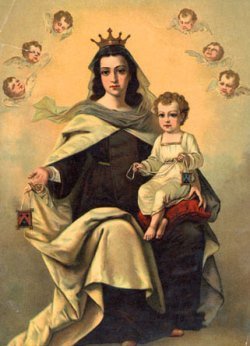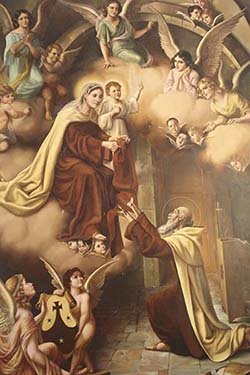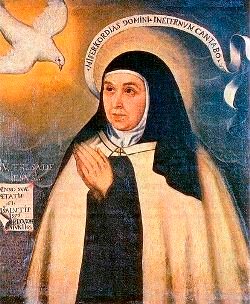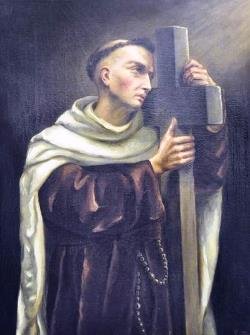 Spirituality is a way of being and becoming. It encompasses not just the way of relating to God but several other aspects of life.
Spirituality is a way of being and becoming. It encompasses not just the way of relating to God but several other aspects of life.
The core of Carmelite Spirituality is transformation into the person of Christ through contemplative stance before God. No one can claim to be a contemplative; it's purely a gift of God. A Carmelite is called to take every possible step in opening oneself to contemplation. She redies her heart, tills it and weeds it. The whole process can be called detachment. The way of opening may vary from person to person. Carmelite Spirituality does not give you a systematic method of prayer. However the Spiritual classics and the ways the Carmelite saints opened themselves to God can be a great source of inspiration.
- Carmelite Spirituality is Christo –centric, "allegiance to Jesus Christ" as rule would put it. It's participation in the life death and resurrection of Jesus Christ. St. Teresa and St. John of the Cross also are deeply Christ centered in their writing. "I started again to love the most Sacred Humanity(of Jesus) prayer began to take shape as an edifice that now had a foundation" Life 24: 2
St. Teresa who is given the title "Mother of Spirituality" defines mental prayer thus: "Mental Prayer in my opinion is nothing else than an intimate sharing between friends, it means taking time frequently to be alone with Him who we know loves us" Life 8:5. No one has so clearly described what happens to the person and within the person while the Paschal mystery is gradually enacted in a person as these two great saints of Carmel. It's a journey inward where trinity awaits.
- Rooted and grounded in the word of God. "Ponder the Lord's law day and night and keeping watch at prayer unless attending to some other duty" Rule Art: 8
What is central to Carmelite spirituality is attentiveness to the word of God. "The sword of the Spirit, the word of God must abound in your hearts and mouths. Let all you do have the Lords word for accompaniment." (Rule. Article 16).
One comes to know Christ and his teaching through prayerful pondering of the word of God. The day is soaked with the word God through the celebration of the Holy Eucharist, celebration of the liturgy of the Hours, Spiritual reading, and reading during the meal time.
- Carmel is Community oriented.
"All must be friends, all must love one another, all must be cherished, and all must help one another" (Way of Perfection 4:7 )
Into the eremitic way of life St. Teresa emphasized a community life style "which is that of a small community in which all are evangelically equal, relations are openly sincere, joys and sorrows are shared and members are committed to one another as Sisters for their entire lives." (Constitutions Article. 88)
- It is around the Eucharist that the community is built.
- Carmelite Spirituality is sustained by Asceticism and Mortification.
"Fix your eyes on the Crucified and everything will become easy for you" Interior Castle 7:4:8
Jesus asks us to deny ourselves and take up our cross and follow him and this involves all forms of self seeking so as to be free to love God and our neighbor, sharing his suffering so as to share his glory
Carmelite Rule gives importance to this aspect and St. Teresa confirms it saying prayer and self seeking does not go together.
- There is no Carmelite Spirituality without Mary. The hidden life of Mary at Nazareth and her pondering over the words of her son overshadows the entire Carmelite Spirituality
Other aspects of Carmelite spirituality are
- love for silence and solitude,
- practice of virtues
- over and above all a great love for the Holy Catholic church. The last words of St. Teresa of Avila, our Holy Mother are "I die a daughter of the Church".

St. Simon stoke (1165) of Kent, England, the sixth General of the Order pleaded with the most Glorious Mother of God to grant some special privileges to the Order of Carmelites, which enjoyed the special title of the Virgin. He prayed devotedly: -
Flower of Carmel, fruitful vine
Splendor of heaven, Mother divine-
None like to thee
Mother of meekness, spotless Virgin,
To the Carmelites a favor impart
Star of the sea.
Surrounded by multitude of angels, the Blessed Virgin appeared to him, holding in her blessed hands the Scapular of the Order. She said: "This shall be a privilege for you and for all Carmelites, that whoever dies clothed in this shall not suffer eternal fire, rather he shall be saved".
The three conditions
- wear the brown Scapular
- observe chastity according to your state of life
- Pray the Rosary

"I was born for you" St Teresa of Avila
"If anyone is thirsty let him come to me and drink" Jnohn 7:37
Even after five centuries St. Teresa of Avila our Holy Mother continues to draw people to the loving waters of Contemplative prayer through her life and writings.
In the life of every person must come a time when he or she feels a call to a spiritual Ideal. The inner awareness and compelling force a higher ideal marks the beginning of a spiritual life, and this is beautifully highlighted in the life of St. Teresa of Avila. "I want to see God" of Teresa was not a wishful desire, but truly a running after God.
- St. Teresa was born on March 28, 1515.
- Entered the Carmelite Order of Incarnation in 1535.
- Founded the Monastery of St. Joseph – a return to the origin- and became the Foundress of the Order of Discalced Carmelites.
What is unchanging and basic to the Teresian Reform of the Nuns is strict enclosure giving oneself fully into the hands of God to be loved and transformed by him. Her autobiography is a spiritual classic which is considered next only to the Confessions of St. Augustine. What she envisaged for others was something that happened in her own personal life and is faithfully recorded under the command of her spiritual director . She founded 17 Monasteries of Discalced Nuns and 15 Monasteries of friars under the unmitigated rule of the Order.
St. Teresa taught to live a life of total prayer in a strict enclosure is a vocation, a particular Charism in the Church and in the world. It is a ministry to the Church and to the world. She was untiring seeker of a personal God who would satisfy her immense capacity to love and be loved. St. Teresa made of her entire life an interior journey so profound that it changed her into a teacher of prayer. Her writings are mainly authoritative teachings on prayer based on her experiences. They are: -
- The Book of Her Life
- Way of Perfection
- The Book of Her Foundations
- The Interior Castle
- Spiritual Testimonies
- Soliloquies
- Meditations on the Song of Songs
Apart from she wrote many letters of which only 450 letters exist.
- 1582- St. Teresa of Avila died in the Monastery of the Annunciation in Alba de Tormes on 4 October.
- 1622- Canonization by Pope Gregory XV.
- 1970- Proclaimed Doctor of the Universal Church by Pope St. Paul VI.

"That the Father, the Son and the Holy Spirit take up Their abode in any one who loved Him." Jn.14:23
The most exciting journey is the journey inward, to the deepest centre of the soul where the Trinity dwells. It's a journey of love. For St. John of the Cross prayer is to fall in love with God who is already in love with us and waiting day and night for our response in the depth of our soul. St. John of the Cross is the best guide ever known to take up this inward journey.
Juan de Yepes y Alvarez was born on June 24, 1542. His parents were Gonzalo and Catalina Alvarez.
He had a very hard living due to the opposition of the marriage of her parents. His Father and one of his two brothers died before he was ten.
"Purest suffering produces purest understanding."
Sufferings of early childhood made him a fine person full of love and compassion for others. It prompted him to set the world aside and seek the true treasure of the Kingdom of God and strive to do everything for the greater glory of God.
His teachings- a radiant refection of his rich inner life- are delightful treasure only to those who are willing to take up this journey of total freedom through a path of love of God and a radical detachment to all that does not help along this path.
St. John of the Cross, the poet mystic explains his doctrine through the sketched form of Mount Carmel symbolic of the meeting place of God.
His writings are:-
- Ascent to Mount Carmel (Books I, II, and III)
- Dark Night of the Soul (Books I and II)
- Spiritual Canticle
- Living Flame of Love
- The minor works
- Poetry
1 Ascent invites us to have a check of things that do not help along the way and helps us to shed that extra luggage, 11 and 111 Ascent speaks of things that help; Faith Hope and Love the tree theological virtues and how to attain it through purification of intellect, memory and will.
1 Dark Night deals with the mortification and fighting with our selfish self that the person has to take up along the journey 11 Dark Night called the period of passive purification is where God purifies the roots and effects of our fallen human nature through trials and difficulties.
Spiritual Canticle is a beautiful poem of 40 Stanzas with explanation. Using the allegory of marital love the mystic explains the loving exchange between the soul and its Beloved who is Christ.
Living Flame of Love speaks of the exalted state of the soul that is liberated and is united with God through transforming union or spiritual marriage.
The popular belief that the teachings of St. John of the Cross hard to follow has only one explanation: The Teachings of Jesus is not easy either. To the one who has found the true treasure it is easy to sell all the rest.
St. john of the Cross played a very important role in the Teresian Reform and is the first friar of the Order and nurtured the Order through his intense prayer life, untiring spiritual direction and joyful acceptance of excruciating sufferings of body, mind and spirit.
This most beloved Son of the Most Virgin Mary flew into the arms of his beloved Lord on Saturday December 14, 1591, at the age of 49.
His last words were "In Manus, Domine, commendo spiritum meum." (Into your hands Lord, I commend my Spirit).
- 1726- Canonization by Pope Benedict XIII.
- 1926- Proclaimed Doctor of the Universal Church by Pope Pius XI.
- 1952- Proclaimed patron of the Spanish poets.
 Spirituality is a way of being and becoming. It encompasses not just the way of relating to God but several other aspects of life.
Spirituality is a way of being and becoming. It encompasses not just the way of relating to God but several other aspects of life.


